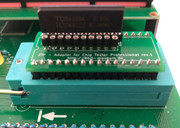Chip Tester de 8bit-museum.de - Reloaded
Moderador: Fundadores
Reglas del Foro
Aquí se puede hablar de proyectos de hardware que no tenga sus esquematicos, o si llevan software que este no disponga del código fuente.
Aquí se puede hablar de proyectos de hardware que no tenga sus esquematicos, o si llevan software que este no disponga del código fuente.
-
cacharreo

- Moderador

- Mensajes: 5767
- Registrado: 09 Ago 2019, 10:17
- Ubicación: /home/cacharreo/
- Has thanked: 1201 times
- Been thanked: 2775 times
- Contactar:
Re: Chip Tester de 8bit-museum.de - Reloaded
Remitiéndome al origen, mis primeras pruebas no fueron insertar un chip al revés sino proporcionar señales (desde lógica programable) en las que entradas y salidas estaban intercambiadas. Al encontrarme que estas configuraciones pasaban los tests, probé con algo -tan absurdo como anecdótico- como un IC real al revés. Para mí, éste es un test puramente simbólico, pero que dé el chip como bueno señala un defecto en alguna parte, en el diseño, en el hardware, en el software o incluso un defecto único de mi chip tester, pero para mí es un defecto que debería investigarse. Como digo es simbólico y aunque sería deseable que una inserción al revés, en otra posición, o incluso que no hubiera ningún chip, etc. fuese detectada o, como poco rechazada, estos no son los únicos casos: uno de los principales problemas de los que estamos manejando ICs es encontrarlos remarcados y precisamente ahí es donde un comprobador de chips sería útil, para detectar que un IC no es el que dice su serigrafía y, de momento, con las pruebas que he hecho -insisto en que no descartemos que mi chip tester puede tener un defecto particular- he encontrado tests para un IC que dan como buenos otros (por ejemplo, el 74HCT14 que pasa el test como un 7400).
Hay otras pruebas que podrían hacerse, por ejemplo obtener el CRC de un IC TTL en las que el software del tester, tal vez, ofrezca un resultado aparentemente coherente. Si aplico un test para una memoria ROM/EPROM o similar sobre un 7400, yo esperaría que el Chip tester fuera capaz de detectar que se trata de un dispositivo del que no pudo leer ni un solo bit, antes de resignarme a aceptar que debo entender que el CRC "calculado" no tiene sentido porque a priori ya sabía que no era una ROM/EPROM.
Hay otras pruebas que podrían hacerse, por ejemplo obtener el CRC de un IC TTL en las que el software del tester, tal vez, ofrezca un resultado aparentemente coherente. Si aplico un test para una memoria ROM/EPROM o similar sobre un 7400, yo esperaría que el Chip tester fuera capaz de detectar que se trata de un dispositivo del que no pudo leer ni un solo bit, antes de resignarme a aceptar que debo entender que el CRC "calculado" no tiene sentido porque a priori ya sabía que no era una ROM/EPROM.
Última edición por cacharreo el 19 Oct 2020, 20:06, editado 1 vez en total.
© cacharreo
- flopping
- Fundador

- Mensajes: 9971
- Registrado: 29 Mar 2013, 15:26
- Ubicación: Valencia
- Been thanked: 122 times
- Contactar:
Re: Chip Tester de 8bit-museum.de - Reloaded
Efectivamente, como ya he comentado anteriormente, las pruebas son para eso, para encontrar "defectos" o "fallos" en los diseños, tu has detectado esos, pero puede que hallan mas, con otros chips o memorias o cualquier IC, eso no se sabe hasta que se prueba y se comprueba en varias maquinas, de diferentes formas, diferentes marcas, familias, etc, etc... por eso las empresas hacen test y versiones diferentes de placas, software, etc...para poder descubrir esos problemas y solucionarlos, como digo, no es tarea facil, ya que si los grabadores-lectores-tester que venden comercialmente, tienen bugs y seguro que estan probados con muchos test y de muchas formas, ¿por que es tan raro que uno domestico tenga bugs?, es lo mas normal del mundo, lo que hay que hacer, es conforme se detecten, ir corrigiendolos en la medida de lo posible y ya esta, no pasa nada.cacharreo escribió: ↑18 Oct 2020, 22:54 Remitiéndome al origen, mis primeras pruebas no fueron insertar un chip al revés sino proporcionar señales (desde lógica programable) en las que entradas y salidas estaban intercambiadas. Al encontrarme que estas configuraciones pasaban los tests, probé con algo -tan absurdo como anecdótico- como un IC real al revés. Para mí, éste es un test puramente simbólico, pero que dé el chip como bueno señala un defecto en alguna parte, en el diseño, en el hardware, en el software o incluso un defecto único de mi chip tester, pero para mí es un defecto que debería investigarse. Como digo es simbólico y aunque sería deseable que una inserción al revés, en otra posición, etc. fuese detectada o, como poco rechazada, estos no son los únicos casos: uno de los principales problemas de los que estamos manejando ICs es encontrarlos remarcados y precisamente ahí es donde un comprobador de chips sería útil, para detectar que un IC no es el que dice su serigrafía y, de momento, con las pruebas que he hecho -insisto en que no descartemos que mi chip tester puede tener un defecto particular- he encontrado tests para un IC que dan como buenos otros (por ejemplo, el 74HCT14 que pasa el test como un 7400).
Hay otras pruebas que podrían hacerse, por ejemplo obtener el CRC de un IC TTL en las que el software del tester, tal vez, ofrezca un resultado aparentemente coherente. Si aplico un test para una memoria ROM/EPROM o similar sobre un 7400, yo esperaría que el Chip tester fuera capaz de detectar que se trata de un dispositivo del que no pudo leer ni un solo bit, antes de resignarme a aceptar que debo entender que el CRC "calculado" no tiene sentido porque a priori ya sabía que no era una ROM/EPROM.
Es logico que cuantos mas chips acepte el tester, mas complejo y dificil, sera el software y/o el hardware y logicamente, tambien se pueden incrementar los fallos, pero poco a poco, todo se soluciona, el problema es que hay miles o quiza millones de combinaciones posibles y controlar todo eso, como digo, es muy dificil, ya que ni los testers profesionales se libran de fallos.
No me hago responsable de mis post pues estan escritos bajo la influencia del alcohol y drogas psicotropicas, por la esquizofrenia paranoide.
(C) 1982-2024, 42 años de ZX Spectrum.
http://www.va-de-retro.com/ un foro "diferente".
Mi juego, que puedes descargar desde aqui
(C) 1982-2024, 42 años de ZX Spectrum.
http://www.va-de-retro.com/ un foro "diferente".
Mi juego, que puedes descargar desde aqui
- slabbi
- El infierno es su lugar

- Mensajes: 176
- Registrado: 23 Ago 2020, 22:14
- Been thanked: 1 time
- Contactar:
Re: Chip Tester de 8bit-museum.de - Reloaded
There is a difference between wishes, what is technically feasible and what is technically feasible in terms of price.
I am not a person who simply claims things without backing them up with facts. I would never argue that most testers are able to detect an incorrectly inserted chip.
I can't speak for all testers, but at least the three commercial ones I own and a few open source testers.
First, I looked at version A and Pro with the TL-866.
For those who do not want to continue reading the result:
The tester can sometimes detect a "wrong" chip (more on that later) before something else happens.
There is no real "wrong insertion" detection at all in logic tests.
I used the 74LS00 for this:

The chip was working well, the Tester has checked all patterns:
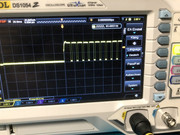
After turning the chip I tried again.
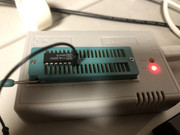
The Tester gave an error as expected:
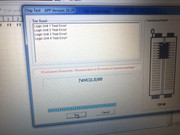
But checking the signals was interesting:
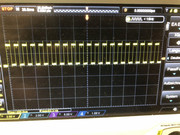
The Tester performed _ALL_ steps, so the result was done in this way:
1. Checking four patterns
2. When all patterns fail, print "Overcurrent protection! External short or incorrect package!"
The whole test tool approx. 500ms.
(btw: My chip tester stops after the first failed pattern after a few milliseconds.)
Ok, "reverse insertion detection" is not working for this.
So I selected a 74245 in the test menu and verified with an real chip if the test works as expected:

Yes it does, so I checked if the software recognizes the smaller chip with 14 pins (the 74LS00):
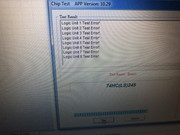
Well, as expected it gave an error message. Not testing the signals:

Note: I am checking the non existing ninth pin. When the Tester senses a smaller chip I expect that it stops and does not perform anything.
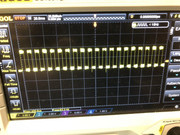
Nope, the tester performs ALL tests. Note it is a smaller chip, so six connections are open.
Later I tried some more TTL chips. The tester does not recognize smaller or larger logic chips, nor when it is inserted backwards. Pin detection was enabled if someone asks. This option seems not to have any effect on logic testing.
Then I do some SRAM checks. The TL-866 does only know a very few Standard SRAMs (xx16, xx64, xx264 and so on). So the databus, addressbus, etc. is mostly at the same position.
First a working and correctly inserted 62256:

Now I turned the 6116:

The tester performs some tests for a few milliseconds:
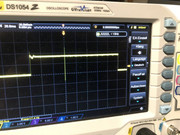
It seems to do a read(?) operation in order to check for the databus pins.
Now I inserted a smaller chip (6116, less pins).
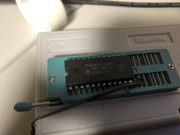
I checked the "missing" pins. It seems that a weak signal is applied and it is checked if a connection exists? What we see is a 3.8V signal:
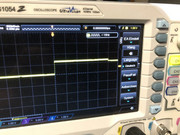
Interesting "pins detected passed" (and databus error).
I turned also this chip and tried again:

So there is some kind of "pin detection" for Non-logic chips, so I checked the manual:
Before operating the chip, the software automatically checks the chip pins for good contact and checks, which in most cases avoids programming or reading errors caused by poor pin contact. Poor contact with the pin the extreme situation: When the pin is particularly serious oxidation, the individual pins may not be completely disconnected (for example, equivalent to a 3-10K contact resistance), in this case cannot determine whether the contact is good, programming errors may occur, so that to old chip, Should carefully handle the pin.(Soaked in dilute hydrochloric acid for 30 seconds, removed after washing with water to dry, to achieve the best results) For very few chips, there may be some pins that can not pass the pin contact check. In this case, this option should be temporarily canceled while ensuring that the pins are in good contact. No pin check will be performed until the chip is read or written.
Well, it says that not for all chips a check can be performed. The tester knows over 15000+ chips (Marketing counting ), So the few dozens logic chips are "a few" chips of course. For all other chips they try to apply a test voltage and check if a shortcut to Vss exists. So they inject a small current, e.g. at some pins and when a shortcut to Vss exists (the signal is pulled down by an internal chip connection), they detect this (as I mentioned some posts before in thinking about what is possible). They say that this may fail with old chips (or when the pin has oxidation, what is not relevant here). So it is a "pin detection", not a "is the chip wrong inserted" detection.
), So the few dozens logic chips are "a few" chips of course. For all other chips they try to apply a test voltage and check if a shortcut to Vss exists. So they inject a small current, e.g. at some pins and when a shortcut to Vss exists (the signal is pulled down by an internal chip connection), they detect this (as I mentioned some posts before in thinking about what is possible). They say that this may fail with old chips (or when the pin has oxidation, what is not relevant here). So it is a "pin detection", not a "is the chip wrong inserted" detection.
"Old chips" mean, that e.g. a 74XX (no LS or HC type) is tested. In that case some chips require a quite high current (remember: BJT is current switched, not voltage switched). So the pin detection will always detect a shortcut and makes no sense here. The TL-866 seems also to use pulldowns which are very useful but that the ATmega does not provide.
It would be nice, of someone could verify these tests. Maybe someone has more information about how the TL-866 detects chips. I was only able to check a few signals with an oscilloscope, I was not able to identify if it was a current limited sense signal or an unlimited one (possible but I have also some other things to do )
)
When I am wrong in some points please feel free to correct this.
Conclusion:
A "wrong usage" detection may only detect a very few issues but seems not to be reliable.
A chip inserted the wrong way cannot detected, so the TL-866 performs all tests. Remember the BJT when the polarity of the collector and emitter is switched? It is still "working" but with a smaller hFE. Depending on the chip (and the manufacturer) you might be able to detect a different voltage drop when you know what to expect for each chip but in general you can not differ. What the TL can detect is a short (<20k Ohm).
This is why other techniques are used but which uses completely different hardware:
https://www.computer.org/csdl/pds/api/c ... xwWoEp/pdf
After all I also checked some open source testers. The "smart testers" are very brutal, either they used lots of test patterns (without current limitation!) in order to identify which pattern were good and so they try to identify the chip, or the "smarter" ones are less brutal and use the pullups to inject a signal (Vcc and GND is always immediately added). Last approach is better but will only work when the inputs accept 250us-500uA (5V/10kOhm + 5V/20kOhm). So it will work with newer chips (e.g. in CMOS), but mostly not with 74xx and you might also get errors with 74LSxx. All (I know) of the existing 4116 testers apply the voltages immediately without any testing before. Also the dozens of other DRAM and SRAM testers.
So, when someone has a good idea how to implement a reliable chip detection using an ATmega, please let me know.
It should detect a wring chip size. When a "wrong" chip is inserted (is is ok, when it is detected that Vss and Vcc have a different position), so a turned chip can be detected.
I am not a person who simply claims things without backing them up with facts. I would never argue that most testers are able to detect an incorrectly inserted chip.
I can't speak for all testers, but at least the three commercial ones I own and a few open source testers.
First, I looked at version A and Pro with the TL-866.
For those who do not want to continue reading the result:
The tester can sometimes detect a "wrong" chip (more on that later) before something else happens.
There is no real "wrong insertion" detection at all in logic tests.
I used the 74LS00 for this:

The chip was working well, the Tester has checked all patterns:

After turning the chip I tried again.

The Tester gave an error as expected:

But checking the signals was interesting:

The Tester performed _ALL_ steps, so the result was done in this way:
1. Checking four patterns
2. When all patterns fail, print "Overcurrent protection! External short or incorrect package!"
The whole test tool approx. 500ms.
(btw: My chip tester stops after the first failed pattern after a few milliseconds.)
Ok, "reverse insertion detection" is not working for this.
So I selected a 74245 in the test menu and verified with an real chip if the test works as expected:

Yes it does, so I checked if the software recognizes the smaller chip with 14 pins (the 74LS00):

Well, as expected it gave an error message. Not testing the signals:

Note: I am checking the non existing ninth pin. When the Tester senses a smaller chip I expect that it stops and does not perform anything.

Nope, the tester performs ALL tests. Note it is a smaller chip, so six connections are open.
Later I tried some more TTL chips. The tester does not recognize smaller or larger logic chips, nor when it is inserted backwards. Pin detection was enabled if someone asks. This option seems not to have any effect on logic testing.
Then I do some SRAM checks. The TL-866 does only know a very few Standard SRAMs (xx16, xx64, xx264 and so on). So the databus, addressbus, etc. is mostly at the same position.
First a working and correctly inserted 62256:

Now I turned the 6116:

The tester performs some tests for a few milliseconds:

It seems to do a read(?) operation in order to check for the databus pins.
Now I inserted a smaller chip (6116, less pins).

I checked the "missing" pins. It seems that a weak signal is applied and it is checked if a connection exists? What we see is a 3.8V signal:

Interesting "pins detected passed" (and databus error).
I turned also this chip and tried again:

So there is some kind of "pin detection" for Non-logic chips, so I checked the manual:
Before operating the chip, the software automatically checks the chip pins for good contact and checks, which in most cases avoids programming or reading errors caused by poor pin contact. Poor contact with the pin the extreme situation: When the pin is particularly serious oxidation, the individual pins may not be completely disconnected (for example, equivalent to a 3-10K contact resistance), in this case cannot determine whether the contact is good, programming errors may occur, so that to old chip, Should carefully handle the pin.(Soaked in dilute hydrochloric acid for 30 seconds, removed after washing with water to dry, to achieve the best results) For very few chips, there may be some pins that can not pass the pin contact check. In this case, this option should be temporarily canceled while ensuring that the pins are in good contact. No pin check will be performed until the chip is read or written.
Well, it says that not for all chips a check can be performed. The tester knows over 15000+ chips (Marketing counting
"Old chips" mean, that e.g. a 74XX (no LS or HC type) is tested. In that case some chips require a quite high current (remember: BJT is current switched, not voltage switched). So the pin detection will always detect a shortcut and makes no sense here. The TL-866 seems also to use pulldowns which are very useful but that the ATmega does not provide.
It would be nice, of someone could verify these tests. Maybe someone has more information about how the TL-866 detects chips. I was only able to check a few signals with an oscilloscope, I was not able to identify if it was a current limited sense signal or an unlimited one (possible but I have also some other things to do
When I am wrong in some points please feel free to correct this.
Conclusion:
A "wrong usage" detection may only detect a very few issues but seems not to be reliable.
A chip inserted the wrong way cannot detected, so the TL-866 performs all tests. Remember the BJT when the polarity of the collector and emitter is switched? It is still "working" but with a smaller hFE. Depending on the chip (and the manufacturer) you might be able to detect a different voltage drop when you know what to expect for each chip but in general you can not differ. What the TL can detect is a short (<20k Ohm).
This is why other techniques are used but which uses completely different hardware:
https://www.computer.org/csdl/pds/api/c ... xwWoEp/pdf
After all I also checked some open source testers. The "smart testers" are very brutal, either they used lots of test patterns (without current limitation!) in order to identify which pattern were good and so they try to identify the chip, or the "smarter" ones are less brutal and use the pullups to inject a signal (Vcc and GND is always immediately added). Last approach is better but will only work when the inputs accept 250us-500uA (5V/10kOhm + 5V/20kOhm). So it will work with newer chips (e.g. in CMOS), but mostly not with 74xx and you might also get errors with 74LSxx. All (I know) of the existing 4116 testers apply the voltages immediately without any testing before. Also the dozens of other DRAM and SRAM testers.
So, when someone has a good idea how to implement a reliable chip detection using an ATmega, please let me know.
It should detect a wring chip size. When a "wrong" chip is inserted (is is ok, when it is detected that Vss and Vcc have a different position), so a turned chip can be detected.
Última edición por slabbi el 19 Oct 2020, 19:48, editado 1 vez en total.
-
cacharreo

- Moderador

- Mensajes: 5767
- Registrado: 09 Ago 2019, 10:17
- Ubicación: /home/cacharreo/
- Has thanked: 1201 times
- Been thanked: 2775 times
- Contactar:
Re: Chip Tester de 8bit-museum.de - Reloaded
Interesantes experimentos.
Edito para añadir una aclaración. El debate sobre la inserción del chip es paralelo y, en mi humilde opinión, creo que el tema se ha desviado porque el origen de todo fueron los falsos positivos sin más. Comprendo un falso positivo en un chip que está al final de su ciclo de vida y presenta fallas transitorias, pero me cuesta mucho más comprender los falsos positivos cuando el chip es otro, cuando el chip está mal posicionado (entradas y salidas no concuerdan) o cuando el chip no está presente.
El ejemplo del gato que se mete en el microondas, lo veo muy cogido por los pelos y de ningún modo aplicable a este caso. Si tuviera que poner uno sería el de una sierra circular que lleva protector, el fabricante podría argumentar que ¿para qué ponerle protector? ¿no sería absurdo, estúpido o de idiotas meter la mano en el disco? Lo cierto es que cuando se están probando chips, uno tras otro, cuando los chips son de color negro, la serigrafía es en general tenue (p.e. el 74HCT00 que he usado), con condiciones de ilumnación concretas (no es lo mismo a la luz del día, que por la tarde o con luz artificial), darle la vuelta a un chip al probarlo va a pasar, en términos probabilísticos es un suceso seguro, y en dichas condiciones no es razonable que sea detectado como correcto, es un mínimo exigible. En las pruebas con otros testers, sea cual sea el sistema de detección que utilicen, sea mejor o peor, lo tengan o no, si "como era de esperar" el resultado es fallo, con eso me basta.
De todos modos estoy seguro de que aquí hay haber un problema relativamente serio de comunicación debido a la barrera idiomática y nos encontramos a lo largo de este tema frases sin sentido, como cuando alguien señala que "el tester es caro", en el sentido de "overpriced" (cuesta mucho más de lo que vale), y acaba entendiéndose como "high-priced/costly" que tiene un precio elevado, conceptos relacionados pero no idénticos.
Y en cuanto a los hechos ("facts") está claro que, parafraseando a un conocido filósofo alemán, no existen los hechos, existen interpretaciones.
Estoy de acuerdo y, como todo, es mejorable, pero obtener un resultado de error en el test hecho en estas circunstancias es lo mínimo que cabe esperar.
Edito para añadir una aclaración. El debate sobre la inserción del chip es paralelo y, en mi humilde opinión, creo que el tema se ha desviado porque el origen de todo fueron los falsos positivos sin más. Comprendo un falso positivo en un chip que está al final de su ciclo de vida y presenta fallas transitorias, pero me cuesta mucho más comprender los falsos positivos cuando el chip es otro, cuando el chip está mal posicionado (entradas y salidas no concuerdan) o cuando el chip no está presente.
El ejemplo del gato que se mete en el microondas, lo veo muy cogido por los pelos y de ningún modo aplicable a este caso. Si tuviera que poner uno sería el de una sierra circular que lleva protector, el fabricante podría argumentar que ¿para qué ponerle protector? ¿no sería absurdo, estúpido o de idiotas meter la mano en el disco? Lo cierto es que cuando se están probando chips, uno tras otro, cuando los chips son de color negro, la serigrafía es en general tenue (p.e. el 74HCT00 que he usado), con condiciones de ilumnación concretas (no es lo mismo a la luz del día, que por la tarde o con luz artificial), darle la vuelta a un chip al probarlo va a pasar, en términos probabilísticos es un suceso seguro, y en dichas condiciones no es razonable que sea detectado como correcto, es un mínimo exigible. En las pruebas con otros testers, sea cual sea el sistema de detección que utilicen, sea mejor o peor, lo tengan o no, si "como era de esperar" el resultado es fallo, con eso me basta.
De todos modos estoy seguro de que aquí hay haber un problema relativamente serio de comunicación debido a la barrera idiomática y nos encontramos a lo largo de este tema frases sin sentido, como cuando alguien señala que "el tester es caro", en el sentido de "overpriced" (cuesta mucho más de lo que vale), y acaba entendiéndose como "high-priced/costly" que tiene un precio elevado, conceptos relacionados pero no idénticos.
Y en cuanto a los hechos ("facts") está claro que, parafraseando a un conocido filósofo alemán, no existen los hechos, existen interpretaciones.
Última edición por cacharreo el 03 Nov 2020, 08:17, editado 4 veces en total.
© cacharreo
- slabbi
- El infierno es su lugar

- Mensajes: 176
- Registrado: 23 Ago 2020, 22:14
- Been thanked: 1 time
- Contactar:
Re: Chip Tester de 8bit-museum.de - Reloaded
Well, maybe you can clarify this:
- El 74HC00 si está bien colocado lo da por malo a veces, y siempre por malo si está al revés.
- El 74HCT14 con la prueba del 7400 siempre falla pero estando bien colocado lo da siempre por malo.
Google translates this to:
- The 74HC00, if it is correctly placed, sometimes considers it bad, and always bad if it is the other way around.
- The 74HCT14 with the 7400 test always fails but being properly placed, it is always considered bad.
First is possible when the chip is not good any more or when the chip requires more current for an input then the tester can deliver (I added a chapter to the updated manual about about this). For the HC this is not a problem but a 5490/8490 (the military version of the 7490) requires -4.8mA input signal, the tester can deliver -5mA, so it is close to the limit. This is why the TL-866 officially only supports HC/LS types.
The second statement I do not understand. When you test a 7414 (inverter) as 7400 (nand) it will fail, so it is correct that the chip always fails. Or is the Google translation incorrect? (if so I think it is not reliable because of this translation, you cannot use it when it cannot translate such simple sentences - think about that - SCNR).
Btw during the last days I did lots of tests and compared these with the TL-866 and guess what, several tests in the TL-866 are quite bad implemented (not complete and will give always positive results). I think no one complains because this feature is not really often used in the TL-866.
I started to review all tests, also all tests that have worked (the current status can be downloaded from my website, download "Overview supported Logic IC" from https://8bit-museum.de/sonstiges/hardwa ... r-english/ ).
I have following options:
- When the test review is done some tests might be removed, the feature will still be available. I will add a note that chips have to be inserted the correct way and in the correct position otherwise a correct test is not possible. Nevertheless, the feature is in the current version is as reliable as from every other tester (some tests are even more reliable then in other testers, since more combinations are tested). But that does not mean it can be improved.
- I remove the feature completely, so nobody has a reason to complain about it. It was a nice add-on but the main functionality of the device is testing memories for which purpose the Tester has been originally developed. In this case i don't have to defend this feature any longer and i have lots of more space for further memory modules.
I have to think about that.
- El 74HC00 si está bien colocado lo da por malo a veces, y siempre por malo si está al revés.
- El 74HCT14 con la prueba del 7400 siempre falla pero estando bien colocado lo da siempre por malo.
Google translates this to:
- The 74HC00, if it is correctly placed, sometimes considers it bad, and always bad if it is the other way around.
- The 74HCT14 with the 7400 test always fails but being properly placed, it is always considered bad.
First is possible when the chip is not good any more or when the chip requires more current for an input then the tester can deliver (I added a chapter to the updated manual about about this). For the HC this is not a problem but a 5490/8490 (the military version of the 7490) requires -4.8mA input signal, the tester can deliver -5mA, so it is close to the limit. This is why the TL-866 officially only supports HC/LS types.
The second statement I do not understand. When you test a 7414 (inverter) as 7400 (nand) it will fail, so it is correct that the chip always fails. Or is the Google translation incorrect? (if so I think it is not reliable because of this translation, you cannot use it when it cannot translate such simple sentences - think about that - SCNR).
Btw during the last days I did lots of tests and compared these with the TL-866 and guess what, several tests in the TL-866 are quite bad implemented (not complete and will give always positive results). I think no one complains because this feature is not really often used in the TL-866.
I started to review all tests, also all tests that have worked (the current status can be downloaded from my website, download "Overview supported Logic IC" from https://8bit-museum.de/sonstiges/hardwa ... r-english/ ).
I have following options:
- When the test review is done some tests might be removed, the feature will still be available. I will add a note that chips have to be inserted the correct way and in the correct position otherwise a correct test is not possible. Nevertheless, the feature is in the current version is as reliable as from every other tester (some tests are even more reliable then in other testers, since more combinations are tested). But that does not mean it can be improved.
- I remove the feature completely, so nobody has a reason to complain about it. It was a nice add-on but the main functionality of the device is testing memories for which purpose the Tester has been originally developed. In this case i don't have to defend this feature any longer and i have lots of more space for further memory modules.
I have to think about that.
Última edición por slabbi el 20 Oct 2020, 20:17, editado 1 vez en total.
-
cacharreo

- Moderador

- Mensajes: 5767
- Registrado: 09 Ago 2019, 10:17
- Ubicación: /home/cacharreo/
- Has thanked: 1201 times
- Been thanked: 2775 times
- Contactar:
Re: Chip Tester de 8bit-museum.de - Reloaded
Cierto, Google no distingue entre sutiles diferencias semánticas como cuando afirmo que la prueba sale como cabía esperar o no (correcta/fallo) o que el resultado de la prueba es OK/FAILED  pero, por descontado, vuelvo a hacer las pruebas con el firmware del mensaje original (0,13β), dejando claro que siempre es la primera prueba tras encender el chip tester. Empezamos con:
pero, por descontado, vuelvo a hacer las pruebas con el firmware del mensaje original (0,13β), dejando claro que siempre es la primera prueba tras encender el chip tester. Empezamos con:
[*] 74HCT14
- Con la prueba del 7400: Chip OK y reinicio (falso positivo)
- Con la prueba del 7400 y el chip girado 180º: Chip OK y reinicio (falso positivo)
- Con la prueba del 7414: Chip OK (correcta)
- Con la prueba del 7414 y el chip girado 180º: Chip FAILED (correcta)
[*] 74LS00
- Con la prueba del 7400: Chip OK y reinicio (correcta, pero no debió reiniciar)
- Con la prueba del 7400 y el chip girado 180º: Chip OK (falso positivo)
[*] 74HC00
- Con la prueba del 7400: Chip OK (correcta)
- Con la prueba del 7400 y el chip girado 180º: Chip OK y reinicio (falso positivo)
[*] 74HCT14
- Con la prueba del 7400: Chip OK y reinicio (falso positivo)
- Con la prueba del 7400 y el chip girado 180º: Chip OK y reinicio (falso positivo)
- Con la prueba del 7414: Chip OK (correcta)
- Con la prueba del 7414 y el chip girado 180º: Chip FAILED (correcta)
[*] 74LS00
- Con la prueba del 7400: Chip OK y reinicio (correcta, pero no debió reiniciar)
- Con la prueba del 7400 y el chip girado 180º: Chip OK (falso positivo)
[*] 74HC00
- Con la prueba del 7400: Chip OK (correcta)
- Con la prueba del 7400 y el chip girado 180º: Chip OK y reinicio (falso positivo)
© cacharreo
- slabbi
- El infierno es su lugar

- Mensajes: 176
- Registrado: 23 Ago 2020, 22:14
- Been thanked: 1 time
- Contactar:
Re: Chip Tester de 8bit-museum.de - Reloaded
Ok, I tried to reproduce this with 74HC14, 74HCT14, 74LS14 and also with 7400, 74HC00, 74HCT00 and 74LS00 (I have no 7414, old type).
1. In none of these tests the tester restarts.
2. Using the v.13 firmware the wrong inserted 74x00 chip is always recognized (in step 3).
3. There ware no false positives or negatives. I checked the 74x00 with 7414 (wrong) tests, and the test fails, and vice vesa.
When you insert a chip the wrong way, then the display contrast becomes a little bit darker because of the higher current (internal short in the chip). Explanation at the end.
The chip (here the LS only) in the correct...
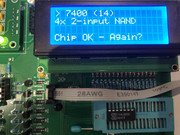
and wrong way...
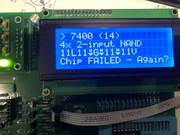
and with the wrong test in the correct position...
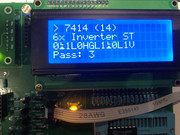
and with the wrong test in the wrong position...
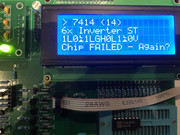
Testing in the wrong position chances the contrast but no reset (the curretn is limited, you also see that the outputs are having the wrong signal)...

The final result...

The same with an HCT chip (not taken photos of 7400 and HC).
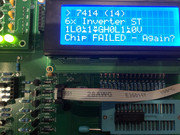
So there must be something wrong with your tester. I usually expect the problem in the software but that a test ends with a positive result even when one pattern must have been wrong because of the chip, seems to be a hardware fault: Either the Tester or the chip. When you have tried several other chips, then most likely the Tester. Can someone confirm cacharreo findings?
Again to the topic "insert the chip the wrong" way test. This is absolute nonsense, rubbish, humbug, idiocy and whatever. Do not do it. It proofs nothing.
When you insert a chip in the wrong direction:
1. The polarity of Vcc and GND is switched:
a) For the transistors it is not a real problem becourse switching emitter and collector will let the transistor still work (npn or pnp in reverse position is still npn and pnp) but the hFE will be much smaller and the transistor might be overloaded.
b) Depending of the design you might get a internal short.
2. Inputs and Outputs are not correct, so there will be two outputs connected which injects current into the chip and you will have unpredictable results. The ATmega is protected and should survive this. Connecting inputs is not a problem, but because of the possible pullups the Tester might read a HIGH. Which is used to calculate the result.
So again - for the last time - when you do not use test equipment correctly you cannot expect valid results.
In particular when the Tester _might_ have a problem you cannot rely on the tests. So I will furher discuss this with cacharreo by email only and try to find with him the problem.
1. In none of these tests the tester restarts.
2. Using the v.13 firmware the wrong inserted 74x00 chip is always recognized (in step 3).
3. There ware no false positives or negatives. I checked the 74x00 with 7414 (wrong) tests, and the test fails, and vice vesa.
When you insert a chip the wrong way, then the display contrast becomes a little bit darker because of the higher current (internal short in the chip). Explanation at the end.
The chip (here the LS only) in the correct...

and wrong way...

and with the wrong test in the correct position...

and with the wrong test in the wrong position...

Testing in the wrong position chances the contrast but no reset (the curretn is limited, you also see that the outputs are having the wrong signal)...

The final result...

The same with an HCT chip (not taken photos of 7400 and HC).

So there must be something wrong with your tester. I usually expect the problem in the software but that a test ends with a positive result even when one pattern must have been wrong because of the chip, seems to be a hardware fault: Either the Tester or the chip. When you have tried several other chips, then most likely the Tester. Can someone confirm cacharreo findings?
Again to the topic "insert the chip the wrong" way test. This is absolute nonsense, rubbish, humbug, idiocy and whatever. Do not do it. It proofs nothing.
When you insert a chip in the wrong direction:
1. The polarity of Vcc and GND is switched:
a) For the transistors it is not a real problem becourse switching emitter and collector will let the transistor still work (npn or pnp in reverse position is still npn and pnp) but the hFE will be much smaller and the transistor might be overloaded.
b) Depending of the design you might get a internal short.
2. Inputs and Outputs are not correct, so there will be two outputs connected which injects current into the chip and you will have unpredictable results. The ATmega is protected and should survive this. Connecting inputs is not a problem, but because of the possible pullups the Tester might read a HIGH. Which is used to calculate the result.
So again - for the last time - when you do not use test equipment correctly you cannot expect valid results.
In particular when the Tester _might_ have a problem you cannot rely on the tests. So I will furher discuss this with cacharreo by email only and try to find with him the problem.
-
cacharreo

- Moderador

- Mensajes: 5767
- Registrado: 09 Ago 2019, 10:17
- Ubicación: /home/cacharreo/
- Has thanked: 1201 times
- Been thanked: 2775 times
- Contactar:
Re: Chip Tester de 8bit-museum.de - Reloaded
Las pruebas anteriores fueron hechas con la versión 0.13β del firmware y, al menos en mi chip tester, los resultados varían bastante según la versión programada. Por ejemplo, con la siguiente versión publicada, la 0.13 -que creo que es la que has usado en tus pruebas- los resultados con los mismos chips son:
[*] 74HCT14
- Con la prueba del 7400: Chip FAILED (correcta)
- Con la prueba del 7400 y el chip girado 180º: Chip FAILED (correcta)
- Con la prueba del 7414: Chip FAILED (falso negativo)
- Con la prueba del 7414 y el chip girado 180º: Chip FAILED (correcta)
[*] 74LS00
- Con la prueba del 7400: Chip OK (correcta)
- Con la prueba del 7400 y el chip girado 180º: Chip FAILED (correcta)
[*] 74HC00
- Con la prueba del 7400: Chip OK (correcta)
- Con la prueba del 7400 y el chip girado 180º: Chip FAILED (correcta)
Sólo hay un falso negativo, el resto de las pruebas salen bien y no se reinicia el tester. Con el TL866IIplus todos los resultados coinciden con los esperados. Todo esto se verá mejor con la siguiente tabla-resumen (utilizando el rudimentario HTML del foro):
(*1) El resultado del test muestra que el chip está invertido o posiblemente invertido.
(*2) Tras mostrar el resultado, el tester se reinicia.
[*] 74HCT14
- Con la prueba del 7400: Chip FAILED (correcta)
- Con la prueba del 7400 y el chip girado 180º: Chip FAILED (correcta)
- Con la prueba del 7414: Chip FAILED (falso negativo)
- Con la prueba del 7414 y el chip girado 180º: Chip FAILED (correcta)
[*] 74LS00
- Con la prueba del 7400: Chip OK (correcta)
- Con la prueba del 7400 y el chip girado 180º: Chip FAILED (correcta)
[*] 74HC00
- Con la prueba del 7400: Chip OK (correcta)
- Con la prueba del 7400 y el chip girado 180º: Chip FAILED (correcta)
Sólo hay un falso negativo, el resto de las pruebas salen bien y no se reinicia el tester. Con el TL866IIplus todos los resultados coinciden con los esperados. Todo esto se verá mejor con la siguiente tabla-resumen (utilizando el rudimentario HTML del foro):
| TL866IIplus | Chip Tester Pro | |||||||
| Firmware 0.13ß | Firmware 0.13 | |||||||
| IC position | Test (selected) | Expected | Result | Expected | Result | Expected | Result | |
| 74LS00 | Normal | 74LS/HC00 | ✓ | ✓ | ✓ | ✓(*2) | ✓ | ✓ |
| Inverted | 74LS/HC00 | 🗴 | 🗴(*1) | 🗴 | ✓ | 🗴 | 🗴 | |
| 74HC00 | Normal | 74LS/HC00 | ✓ | ✓ | ✓ | ✓ | ✓ | ✓ |
| Inverted | 74LS/HC00 | 🗴 | 🗴(*1) | 🗴 | ✓(*2) | 🗴 | 🗴 | |
| 74HCT14 | Normal | 74LS/HC14 | ✓ | ✓ | ✓ | ✓ | ✓ | 🗴 |
| Inverted | 74LS/HC14 | 🗴 | 🗴(*1) | 🗴 | 🗴 | 🗴 | 🗴 | |
| Normal | 74LS/HC00 | 🗴 | 🗴 | 🗴 | ✓(*2) | 🗴 | 🗴 | |
| Inverted | 74LS/HC00 | 🗴 | 🗴(*1) | 🗴 | ✓(*2) | 🗴 | 🗴 |
(*1) El resultado del test muestra que el chip está invertido o posiblemente invertido.
(*2) Tras mostrar el resultado, el tester se reinicia.
Última edición por cacharreo el 07 Nov 2020, 14:56, editado 4 veces en total.
© cacharreo
- slabbi
- El infierno es su lugar

- Mensajes: 176
- Registrado: 23 Ago 2020, 22:14
- Been thanked: 1 time
- Contactar:
Re: Chip Tester de 8bit-museum.de - Reloaded
Well, that sounds good. The .13b modifies the testing significantly. I will send you an updated version soon. Have you tried the version I sent you two days ago? You can see in the attached matrix which chips have been already verified using the new code.
The "false positive", please could you post a picture of the display output?
The should be one or more up/down arrows with H/L. An L^ means that LOW was read but HIGH expected. An Hv means a HIGH was read but a LOW expected.
Comparing this with the datasheet helps to find the corresponding gate. Except from the Schmitt-Trigger the 7414 is a simple inverter, so knowing what signal was read wrong helps to check the chip on the breadboard. Maybe it was not a "false negative"?




